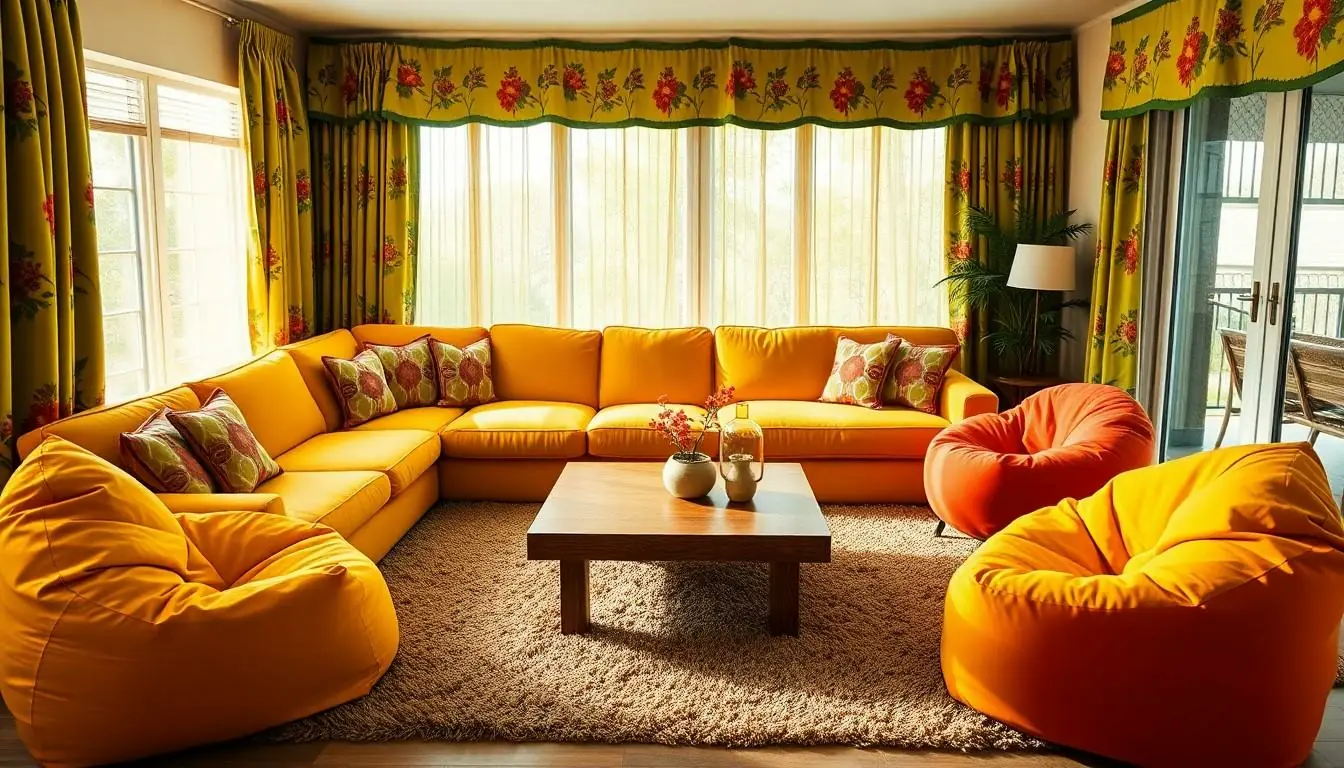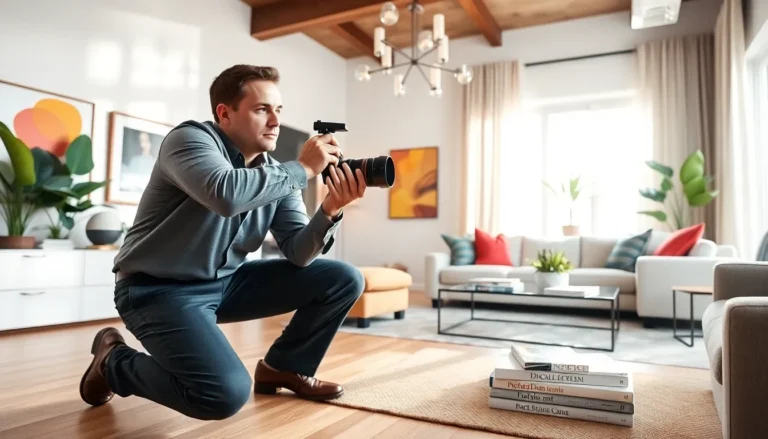Step into a time machine and travel back to the groovy 70s, where living rooms were a kaleidoscope of colors, patterns, and textures. Imagine sinking into a plush avocado green sofa while surrounded by bold floral prints and funky wall art. This was an era when interior design dared to be loud, proud, and unapologetically unique.
If you think modern minimalism is all the rage, think again! The 70s taught us that a splash of orange, a hint of brown, and a whole lot of personality can transform a dull space into a vibrant haven. Get ready to embrace the retro charm and discover how to bring that playful spirit back into today’s homes. After all, who wouldn’t want to lounge like it’s 1975?
Table of Contents
ToggleOverview Of Living Room 70s Interior Design
Living room interior design in the 1970s embraced boldness and creativity. Color palettes often featured vibrant shades like avocado green, mustard yellow, and burnt orange. These dynamic hues created inviting and energetic spaces that offered a stark contrast to the more subdued tones of previous decades.
Furniture choices during this era prioritized comfort and style. Large sectional sofas often dominated living rooms, providing ample seating for family gatherings. Materials like suede and corduroy were prevalent for upholstery, adding texture to the overall aesthetic.
Patterns played a significant role in the 70s design. Geometric prints and floral motifs adorned wallpapers and fabrics, contributing to the lively ambiance. Rugs often featured shag textures, further enhancing the tactile experience within living rooms.
Lighting fixtures also contributed to the unique charm of the 70s. Hanging pendant lights and lava lamps became essential design elements. These fixtures not only provided illumination but also served as statement pieces, capturing the playful spirit of the decade.
Decor items showcased personal expression. Wall art, including macramé hangings and abstract paintings, added character to the living space. Accessories like vintage record players and retro bookshelves completed the look, embodying the era’s eclectic style.
Ultimately, living room design in the 70s fused functionality with artistic expression. This period encouraged individuality, making it easy to see why some homeowners continue to draw inspiration from its vibrant aesthetic today.
Key Characteristics

The living room design of the 1970s showcased distinctive features that set it apart. This decade embraced vivid colors, expressive patterns, and comfortable furniture, creating lively yet inviting spaces.
Color Palettes
Avocado green, mustard yellow, and burnt orange became the hallmark shades of the era. These bold hues worked together to evoke energy and warmth in living rooms. Bright accent colors often appeared alongside these primary tones, enhancing visual interest. Combinations of contrasting colors created a vibrant atmosphere, encouraging playful interactions.
Furniture Styles
Large sectional sofas dominated living rooms, promoting relaxation and socializing. Upholstered options in textured materials, like suede and corduroy, added comfort and an inviting feel. Retro coffee tables frequently featured unique shapes, often emphasizing natural materials. Decorating with bean bag chairs and inflatable furniture invited a casual and fun vibe, reinforcing the era’s carefree spirit.
Textiles And Patterns
Geometric prints and floral motifs adorned upholstery and wallpaper, creating eye-catching designs. Textures played a significant role, with shag rugs enhancing comfort underfoot. Heavy drapery likely framed windows, showcasing bold patterns and rich colors. Using mixed fabrics in throw pillows and blankets added depth, encouraging personal expression through decor.
Popular Design Elements
The 1970s brought a distinctive flair to living room design. This era encapsulated boldness through unique elements, with individuality thriving in every home.
Lighting Fixtures
Lighting fixtures defined the atmosphere of 70s living rooms. Lava lamps became iconic, offering soft, colorful illumination. Pendant lights in sculptural designs added an artistic touch. Floor lamps often showcased bold patterns or unusual shapes, serving as focal points. chandeliers featured intricate designs that meshed with the playful aesthetic. Each choice aimed to enhance a relaxed yet vibrant ambiance, creating inviting spaces.
Wall Art And Decor
Wall art showcased eclectic styles and bold patterns. Large, abstract paintings dominated walls, often in striking colors. Framed prints reflected popular cultural themes, contributing to the room’s character. Tapestries adorned some walls, adding texture and warmth. Decorative mirrors created a sense of spaciousness while featuring unique shapes or frames. These elements together celebrated the free spirit of the 70s, encouraging personal expression in every living room.
How To Incorporate 70s Design Today
Incorporating 70s design into contemporary homes brings warmth and vibrancy. This era’s playful ethos inspires a creative blend of old and new styles.
Mixing Modern And Vintage
Mixing modern and vintage elements creates a dynamic living room. Start by selecting a centerpiece like a bold avocado green sofa, pairing it with minimalist furniture for balance. Accent chairs with geometric patterns can complement sleek lines of modern tables. Artwork from the 70s, such as abstract pieces or tapestries, enhances the vintage flair while contrasting effectively with contemporary decor. Adding a shag rug anchors the space and invites texture. Light fixtures, like sculptural pendant lights, can serve as focal points that bridge past and present seamlessly. A vibrant color palette, incorporating mustards and burnt oranges, infuses energy, making the room feel inviting and eclectic.
Affordable 70s-Style Decor
Affordable 70s-style decor options abound for budget-conscious homeowners. Thrift stores often stock vintage finds like retro coffee tables and unique lighting fixtures, perfect for an authentic touch. DIY projects can transform modern items into 70s statements; for example, painting a side table in a bold hue or reupholstering chairs with textured fabrics. Incorporating patterned throw pillows and blankets can revive vintage aesthetics without overspending. Repurposing decorative mirrors adds dimension while celebrating the lively spirit of the decade. Faux plants can mimic the era’s love for nature, adding life to any space at a fraction of the cost. Embracing these elements creates a nostalgic atmosphere, allowing homeowners to enjoy 70s charm in an affordable way.
Embracing the vibrant spirit of 70s interior design can breathe new life into modern living spaces. By incorporating bold colors and playful patterns homeowners can create inviting environments that reflect their unique style. The charm of the 70s lies in its fearless approach to decor which encourages experimentation and personal expression.
Mixing vintage elements with contemporary pieces allows for a dynamic aesthetic that honors the past while remaining relevant today. Simple additions like patterned throw pillows or statement lighting can evoke nostalgia without overwhelming a space. Ultimately the 70s offer a rich source of inspiration for those looking to infuse warmth and creativity into their homes.



